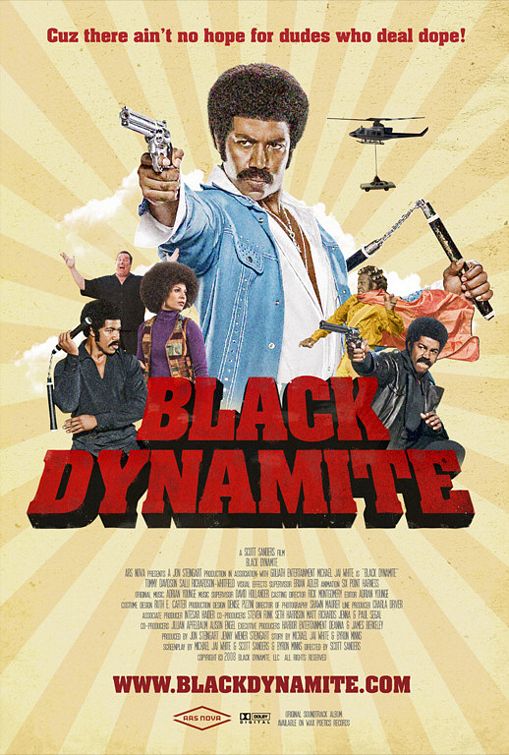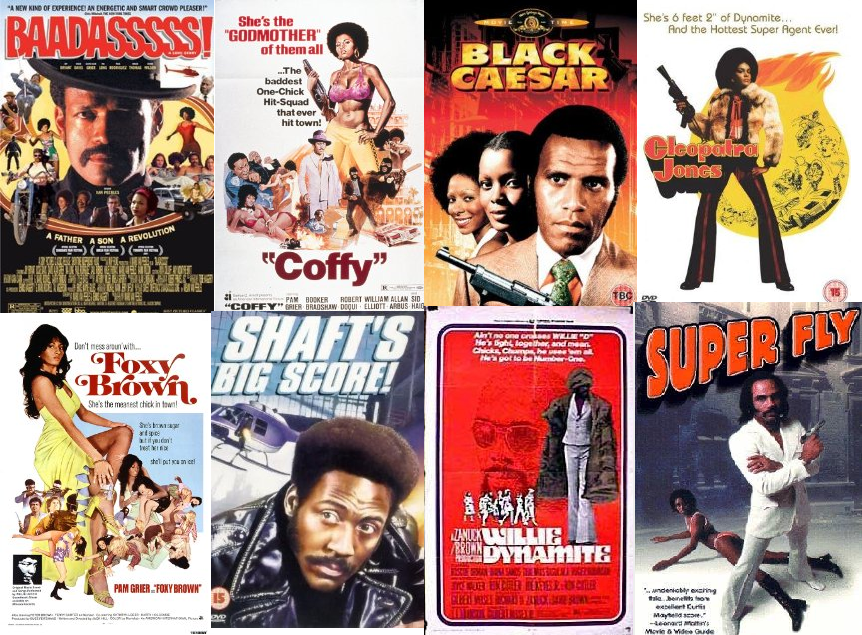
This week at Daily Grindhouse we’ve taken a look at some of our favorite black-centered films and actors, from the comedic contributions of Dudley Dickerson to the contemplative drama GORDON’S WAR. Today’s focus is on an era from the early to mid-1970s, the culturally significant cinema it produced, and how BLACK DYNAMITE gave it the side-splitting appreciation it deserves.
Grindhouse cinema at large has long stood as an umbrella medium, housing multiple low-brow, light-budget film genres aimed mostly at male audiences of the lower social stratum. Not only would these theaters show sexually graphic fare, but they would run double and triple features of bizarre horror, imported marital arts movies from Hong Kong, and blaxploitation films. Originally the ethnic genre, so-named by merging the terms “black” and “exploitation”, were crafted and marketed to black audiences, but their popularity quickly swelled. From SWEET SWEETBACK’S BADASSSSS SONG (1971) to DISCO GRANDFATHER (1979), blaxploitation’s appeal spread across race and ethnicity with ease. Filmmakers and independent studios of the genre held fast to the maxim, “If it ain’t broke, don’t fix it.” The vast majority of action-driven blaxploitation movies followed a similar formula: typically taking place in poor urban areas, a heroic black male lays down the hammer to take back the streets from a sinister organization or criminal element, and do right by his community. Featuring funky, bass-heavy soundtracks like those in SHAFT and SUPERFLY, a litany of pre-shaped characters that became a trope unto themselves, and on-the-nose dialogue delivered in the glorious jive slang of the era, blaxploitation has since achieved cult status among cinema buffs all over the world.

The formulaic nature of the genre, while popular, lends itself to self-deprecating parody. Great parody is, at its core, simple imitation thrown on a curve. The cult success of films like THE NAKED GUN trilogy, AIRPLANE!, and I’M GONNA GIT YOU SUCKA lie in their ability to take themselves seriously on a superficial level, just as their previous earnest complements did. BLACK DYNAMITE has a fully formed plot from start to finish, one that is an amalgamation of any number of plots we’ve seen in the films it ridicules. The ex-commando is reluctantly recruited to clean up the crime in his neighborhood (as any BLACK BELT JONES fan has already seen), with the help of a rhyming, tough-talking heavy (like DOLEMITE). He confronts thugs in the local hangout, the pool hall (a scene featured in TROUBLE MAN and BLACK BELT JONES) in an effort to extract information. Eventually, a larger (white) conspiracy is uncovered, with aims to poison the black community (a scheme most notably seen in 1974’s THREE THE HARD WAY). The makers of BLACK DYNAMITE succeed in objectively deconstructing the genre while providing consistent quality comedy in its 84 minute runtime.
From the IMDb summary: “This is the story of 1970’s African-American action legend Black Dynamite. The Man killed his brother, pumped heroin into local orphanages, and flooded the ghetto with adulterated malt liquor. Black Dynamite was the one hero willing to fight The Man, all the way from the blood-soaked city streets to the hallowed halls of the Honky House.”
After a faux ’70s commercial for Anaconda Malt Liquor (a substance that pops up throughout the movie), BLACK DYNAMITE opens with a scene familiar to any cinephile: a group of respected crime bosses are summoned before a mysterious mafioso, who then fingers one of them as a rat and summarily kills him. This man turns out to be Jimmy, the brother of former CIA agent and Vietnam veteran Black Dynamite. When Captain Yancy uncovers Jimmy’s body, he laments: “My God, men. Do you know what this means? Do you know whose brother… ? This ghetto is gonna be turned upside-down, I tell you, upside-down. The streets are gonna run crimson with the blood of the men responsible for his brother’s death. Man I’m speaking of is a veritable one-man army. And if you get on his bad side, brother, you’re done for. It’s only a matter of time before he finds out. And when he does, no matter where he is, get ready, gentlemen, because hell’s a-coming. Coming, coming, coming…” The rant is intercut with grainy action footage of urban upheaval, and establishes the playful tone of the film by sending up a familiar plot device. Sanders and White make it absolutely clear that their film fits snugly in a specific cultural niche, and it works.

BLACK DYNAMITE introduces genre characters with the zeal of any good spoof, through commonplace scenes from your everyday genre classic. We have the macho protagonist, whose misogyny doesn’t hurt his numerous flings with the ladies. We have the Irish cop/government agent who begs the hero: “We need you…now more than ever,” even after the hero insists that he’s out of the game. We have the fly pimp daddy (in this film, an entire Pimp Counsel in homage to 1974’s WILLIE DYNAMITE). Controversial elements of black power were presented via the black militant commandos, most famously known in 1973’s THE SPOOK WHO SAT BY THE DOOR. There’s the shifty-eyed neighborhood informant with the word on the street, the “mama hen” madam (TRUCK TURNER, anyone?), and a litany of other characters. These caricatures converge in routine settings of the period to maximize their comedic potential and raise the repeat viewing value. In a scene lifted directly from BLACK BELT JONES (1974), Black Dynamite enters a pool hall full of hardened thugs and attempts to uncover information related to his brother’s death. Words are exchanged, and he’s forced to show them who they’re dealing with.
The pool hall fight sequence is a perfect example of the multilayered spoofing at play. Not only are the clothes, conversations, and set pieces evocative of the cinematic era being lampooned, but the mistakes one is likely to see while watching any blaxploitation classic is purposely included in the experience. With the exception of megahits like SHAFT, poor production value was the norm in blaxploitation. The makers of BLACK DYNAMITE were fully cognizant of this and saw the comedic value in it. As a result, the film is full of “mistakes” like obvious stunt doubles and boom mikes skimming the top of the frame. Car rides are done in obviously stationary vehicles positioned before blue screens. The jumpy camera wobbles, striving to keep up with the action as a character suddenly stands up. In the pool hall, Black Dynamite briefly loses his weapon before an unseen assistant tosses it back to him from off-screen. One of the film’s most hilarious moments comes from the poorly-choreographed pool hall fight wherein the character Bullhorn slaps his opponent, who is immediately replaced with a blatantly different stunt double. The screenwriters purposely inserted film-school abomination scenes full of expositional dialogue stretches. Oddly enough, the love of black action films of that decade shows in its lack of production quality.
It’s apparent that BLACK DYNAMITE was a passion project made by genuine enthusiasts of the genre. In an interview with the A.V. Club, Michael Jai White explains that the idea for BLACK DYNAMITE was born while he was listening to a James Brown song. He did an in-character photo shoot to set the tone of the film, and showed the photos to director Scott Sanders, who filmed a trailer to show around. Funding was quickly secured, and so Sanders and White sat down with Byron Minns (who plays Bullhorn in the film) and hammered out a script in just under three weeks. Their love of blaxploitation is apparent in their acknowledgment of the genre’s weaknesses while still maintaining affection for the little things they love. Consider this scene from 1974’S WILLIE DYNAMITE, in which the local pimps gather to discuss recent run-ins with the police:
Several things make the scene memorable, from the acknowledgment via pointing, to the flamboyant over-the-top dialogue, to the behind-the-scenes ruminations on the state of the pimping business. Now take a look at my favorite scene from BLACK DYNAMITE, lovingly known as “The Pimp Counsel” scene:
How many different ways did they clown on (and show love to) that classic WILLIE DYNAMITE scene?
Even if only for moments at a time, BLACK DYNAMITE takes itself seriously, and plays like the sort of grindhouse fodder it skewers. At the heart of most action blaxploitation films is the message of doing everything in your power to help your community overcome systemic, insidious oppression. BLACK DYNAMITE manages to carry this same message while hilariously approximating its previous carriers of yesteryear. In an age of commodity genre spoofs that stumble between pop culture references and the same old poop/weed jokes, BLACK DYNAMITE has what’s missing from so many genre spoofs today: it’s actually funny. Scott Sanders walks the fine line between caricature and buffoonery with fully functional characters and a plot that’s laughable but consistent with the films of the genre’s heyday. Whatever outta sight movies you decide to watch this month, it’s only proper to bring the blaxploitation screening binge to a close with BLACK DYNAMITE.
I can dig it.
Tags: Adrian Younge, Arsenio Hall, Black History Month, Black History Month Week, Cedric Yarbrough, Chris Spencer, John Salley, Kevin Chapman, Michael Jai White, Miguel A. Núñez Jr., Mike Starr, Nicole Ari Parker, Nicole Sullivan, Obba Babatundé, Phil Morris, Richard Edson, Salli Richardson, Scott Sanders, The 1970s, Tommy Davidson, Tucker Smallwood


No Comments